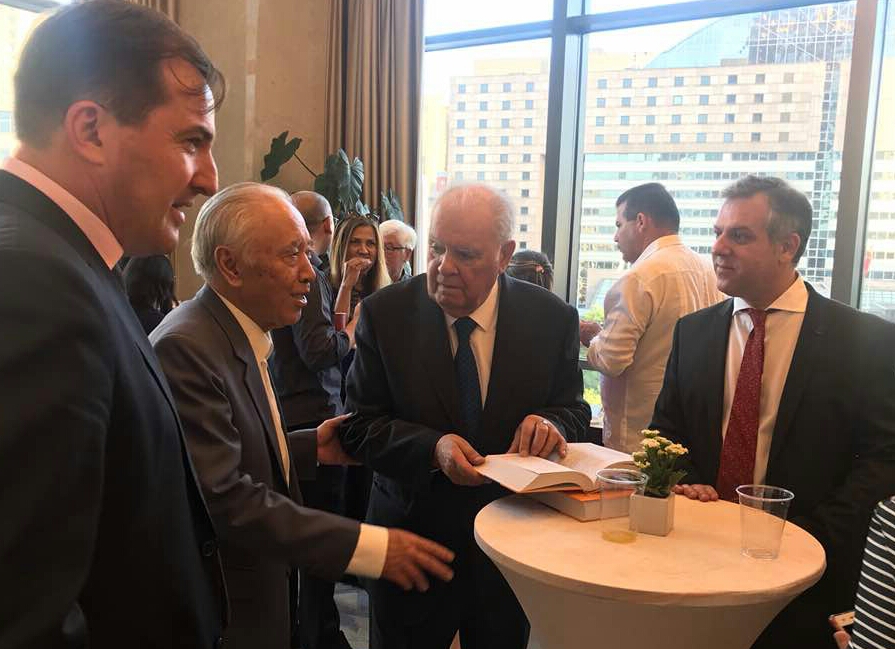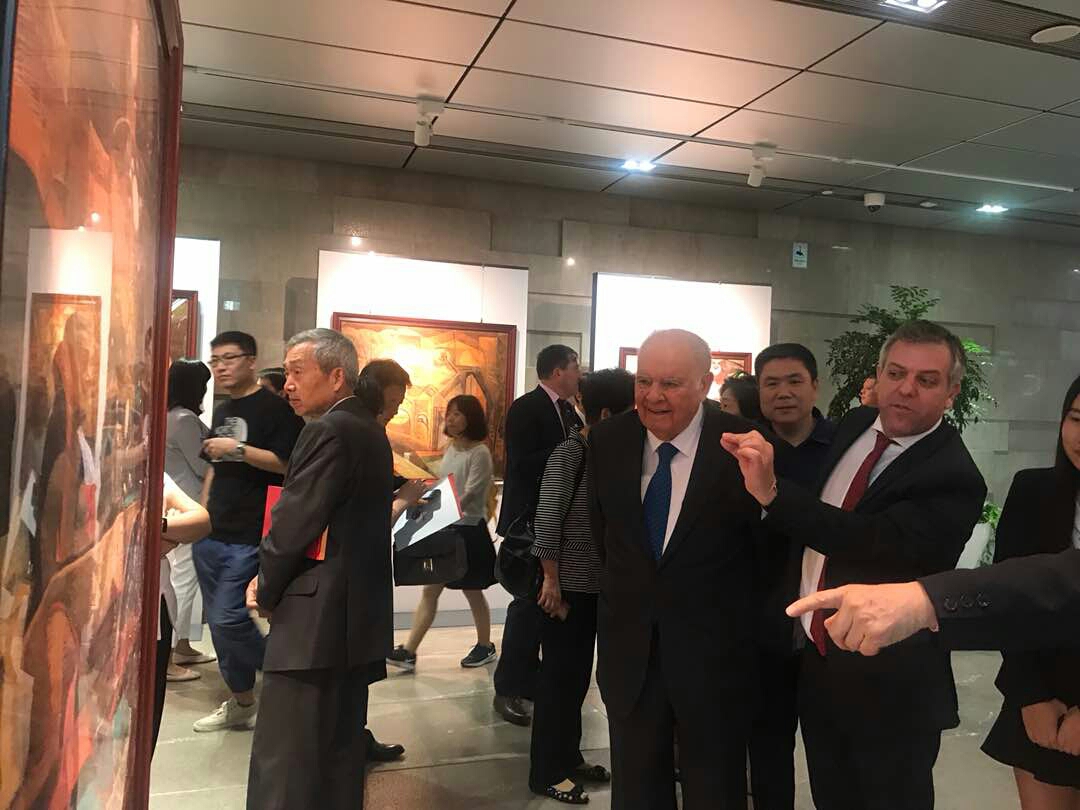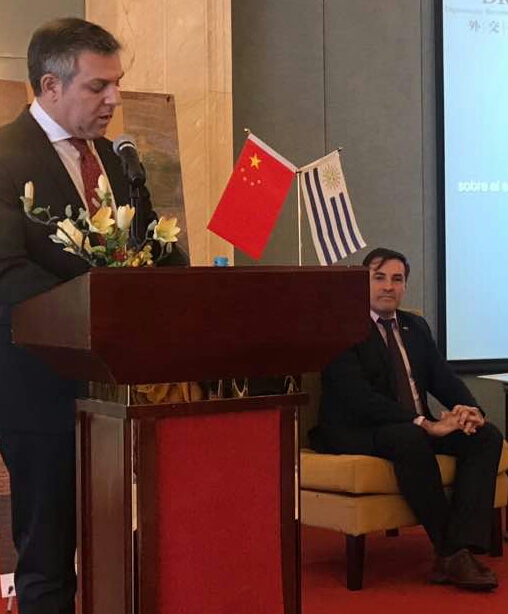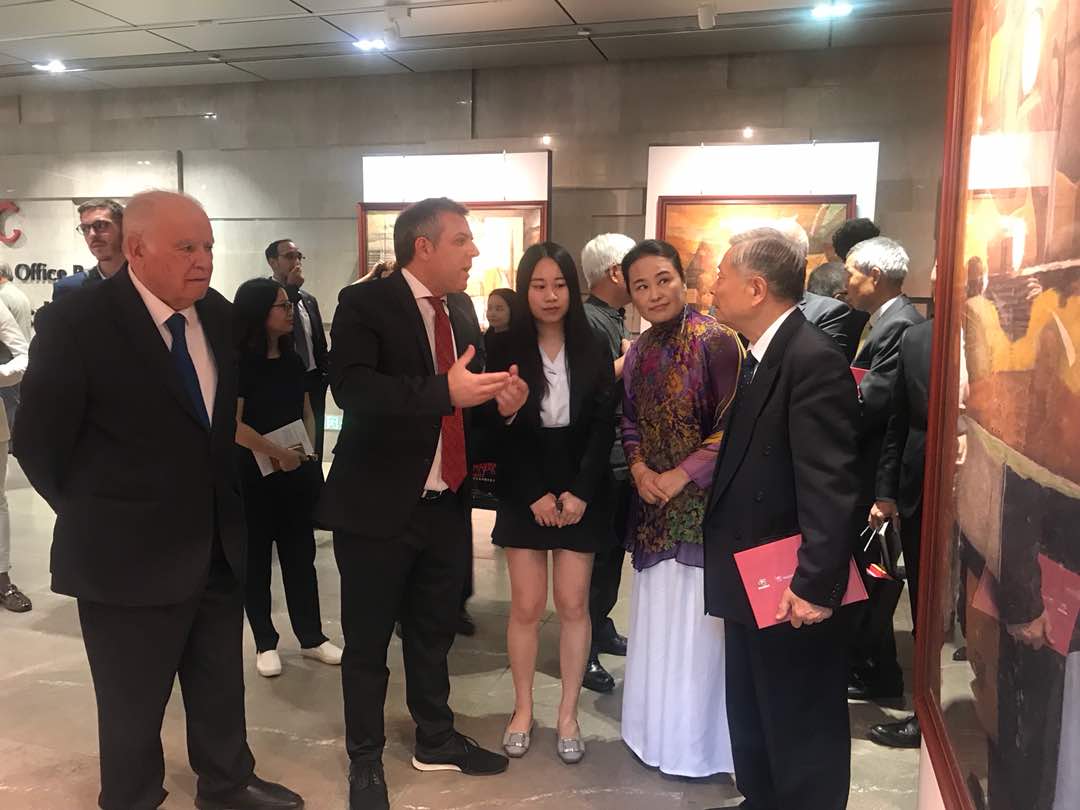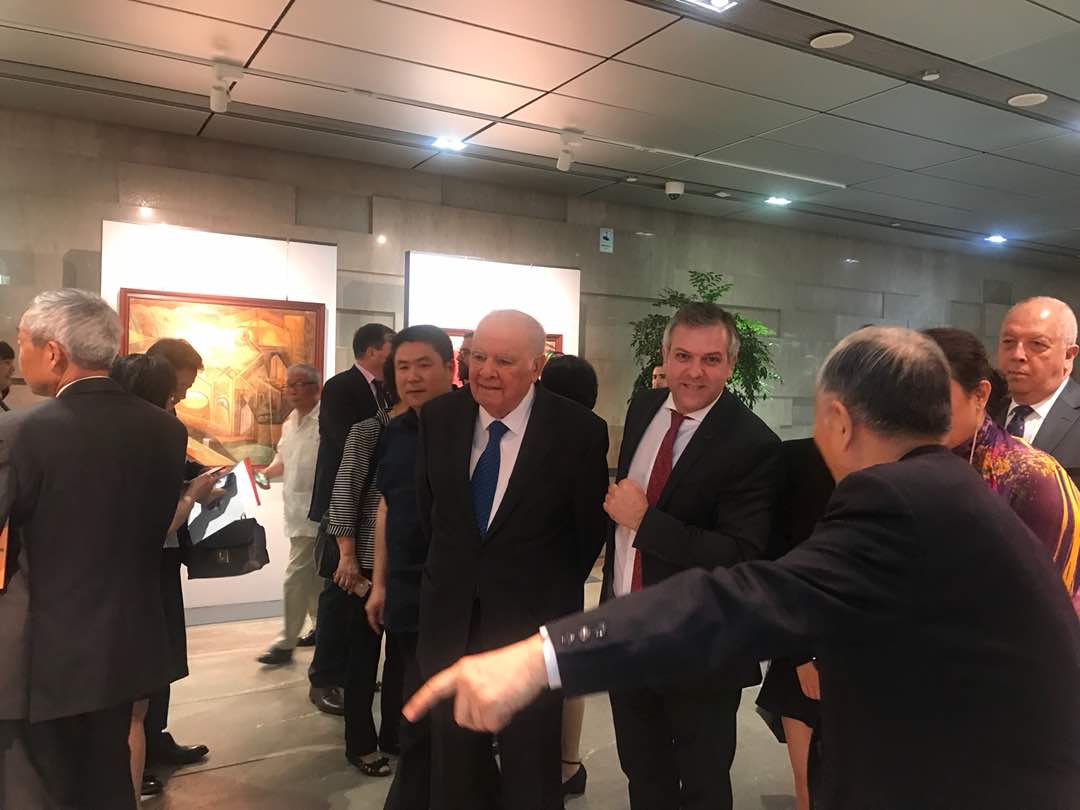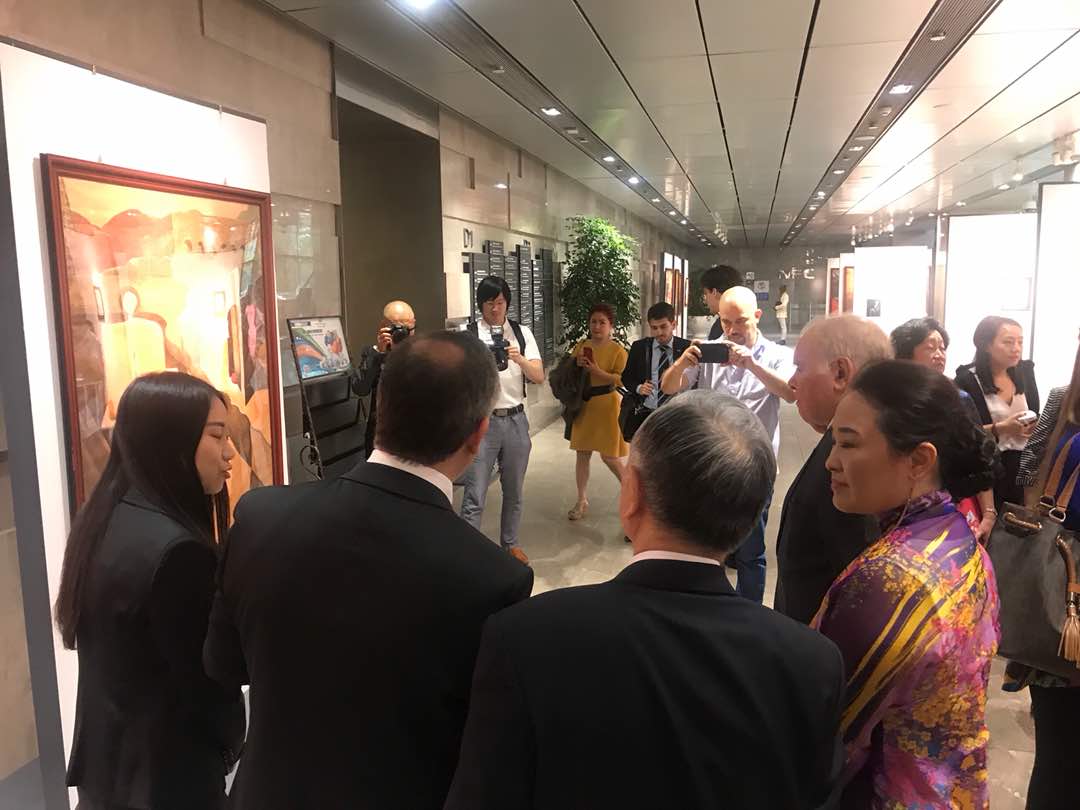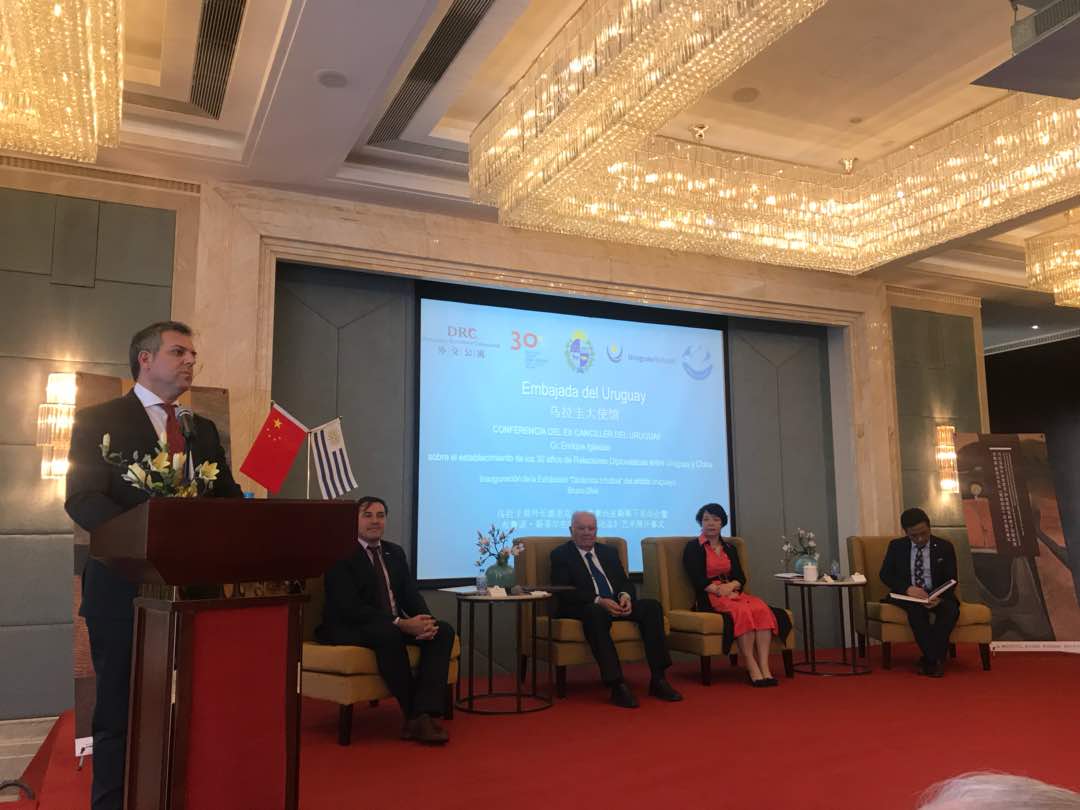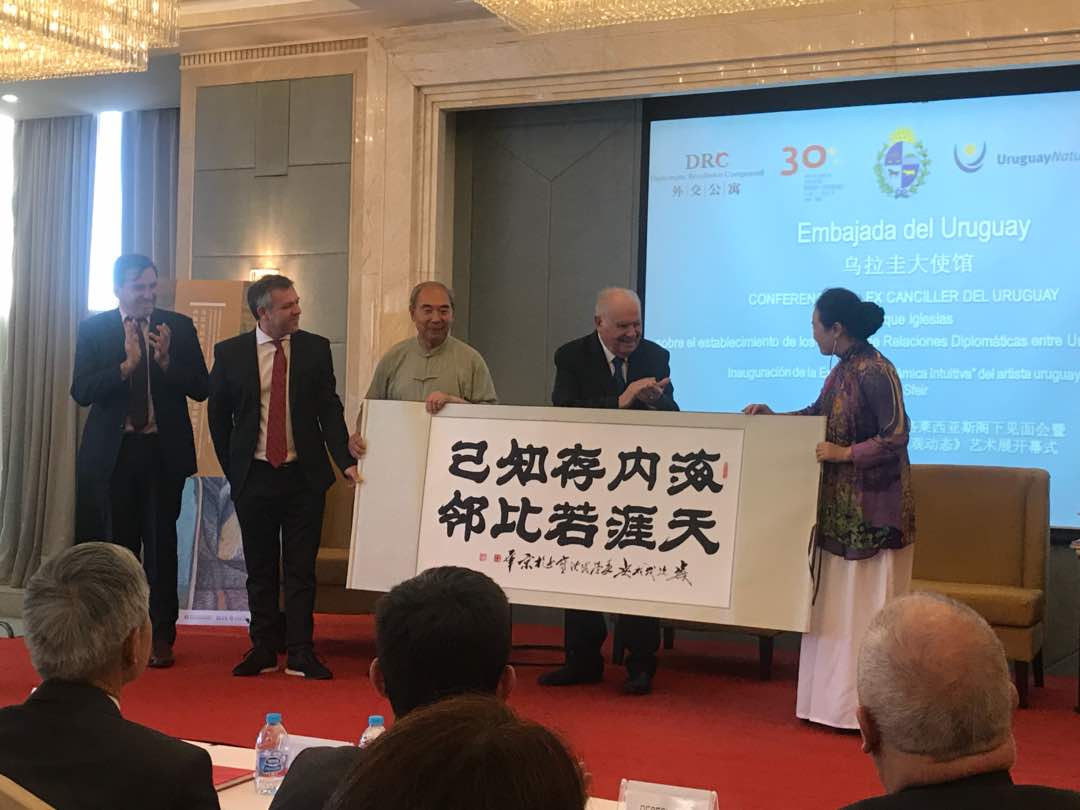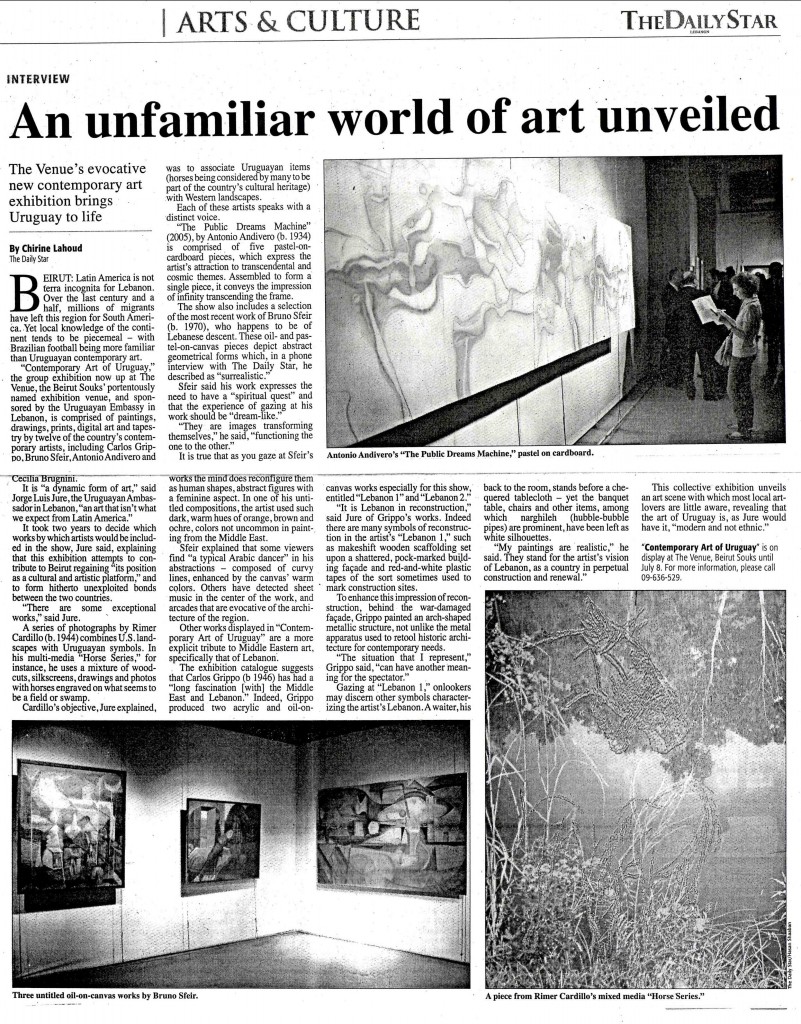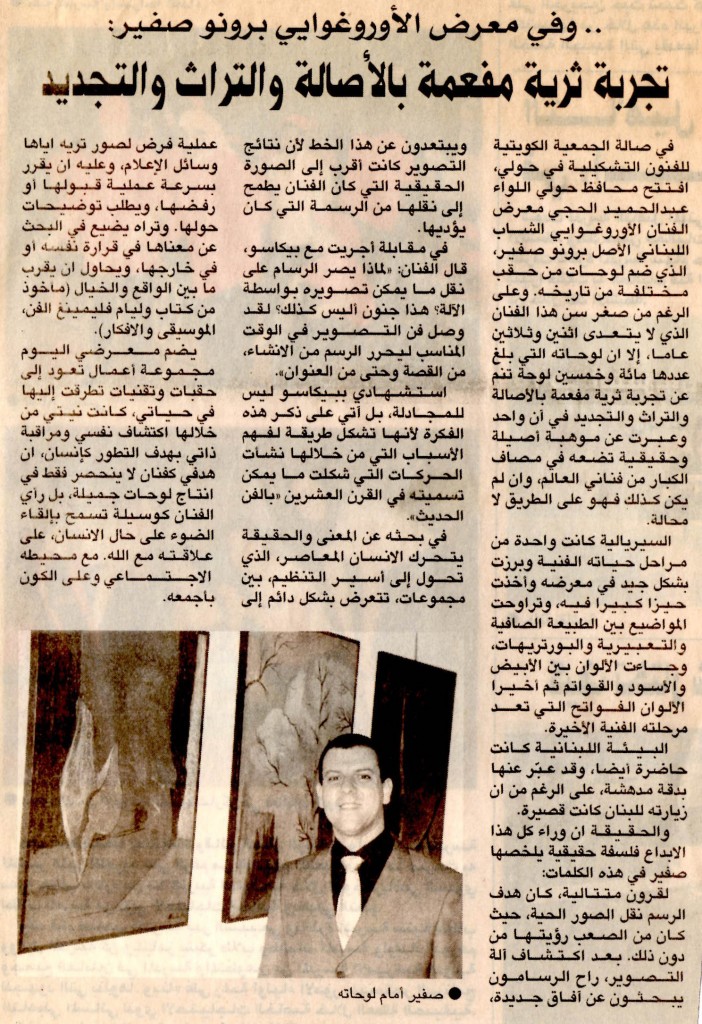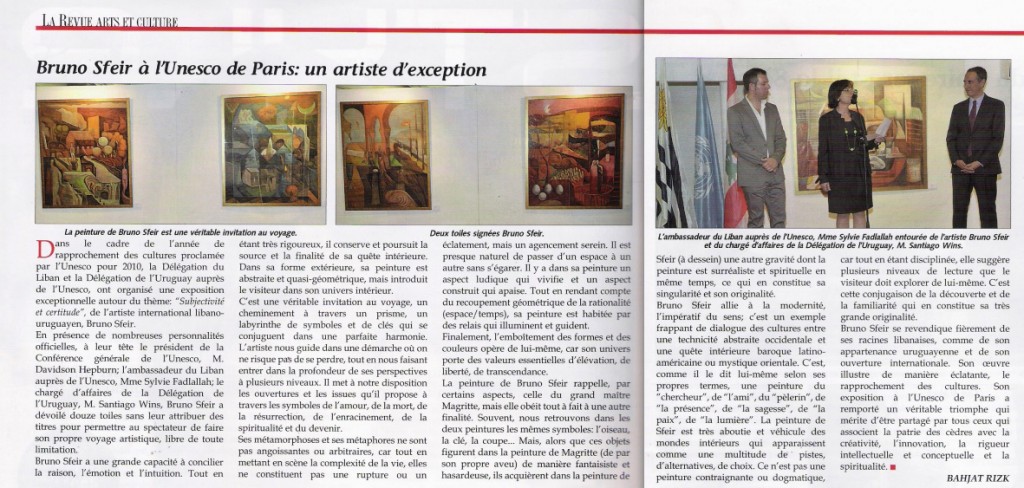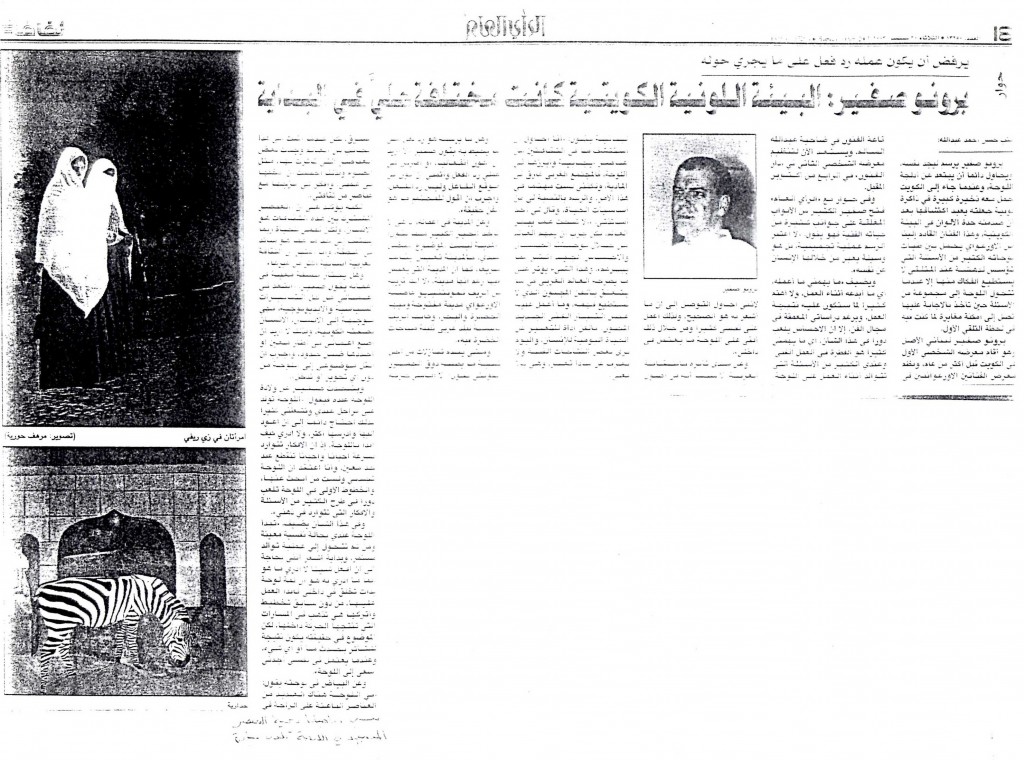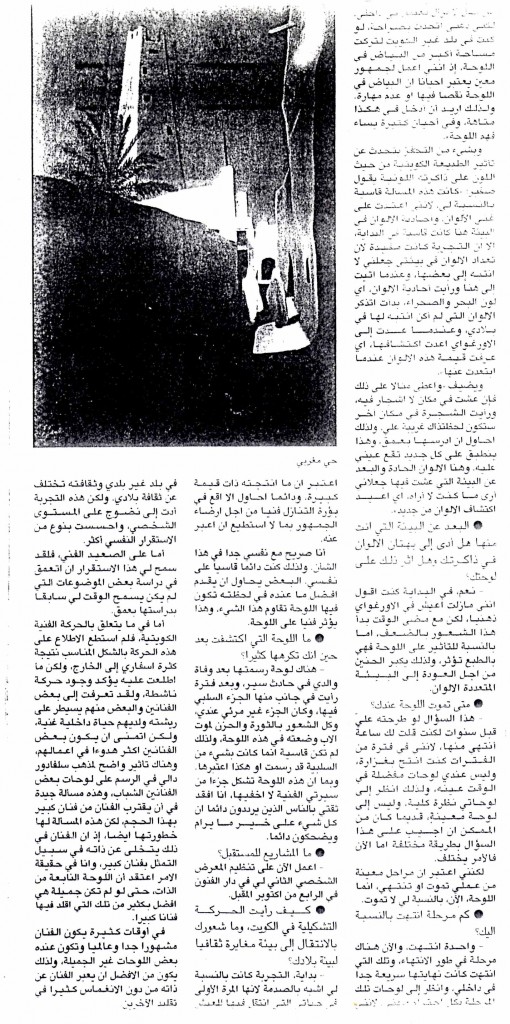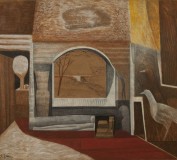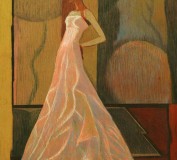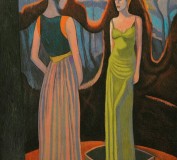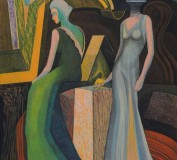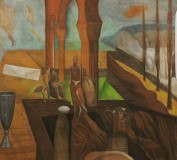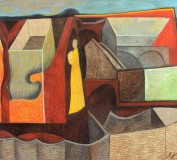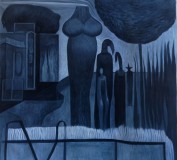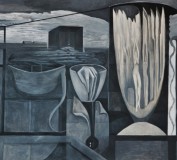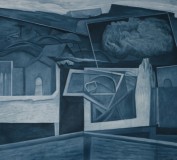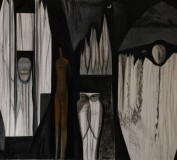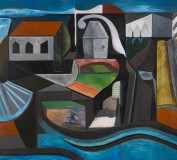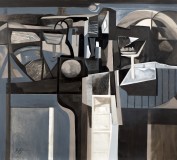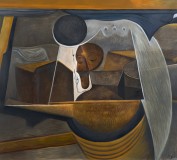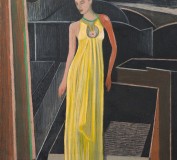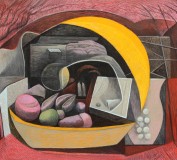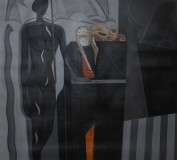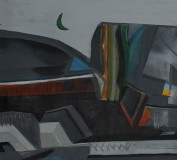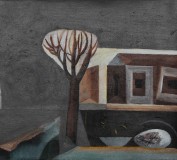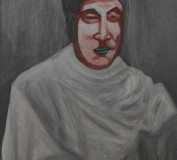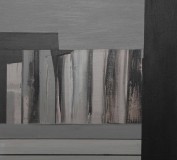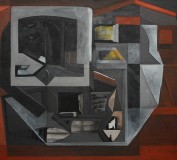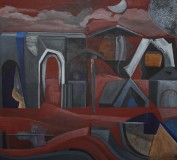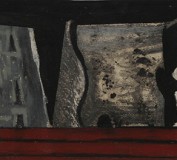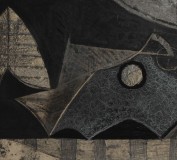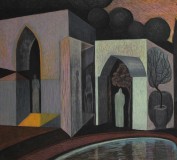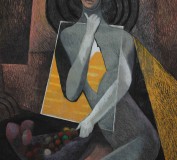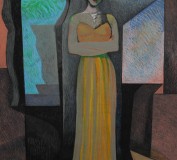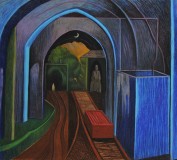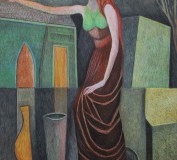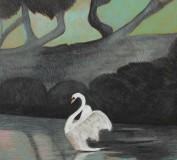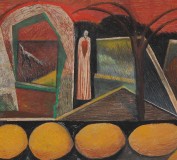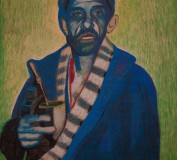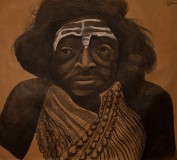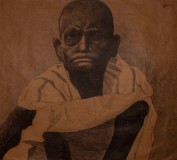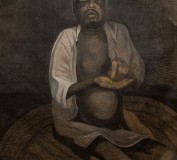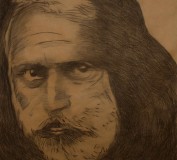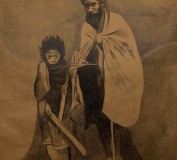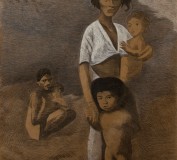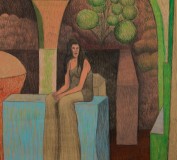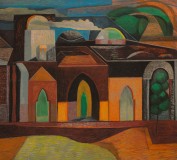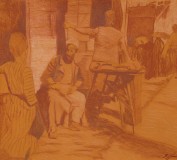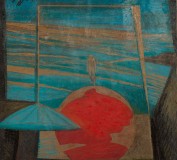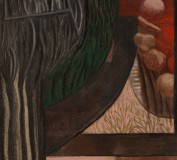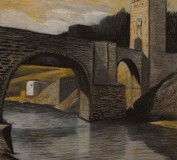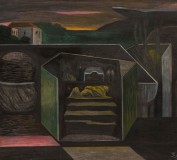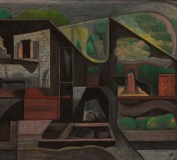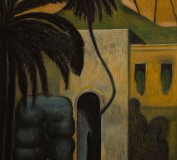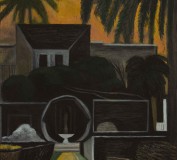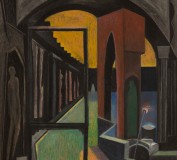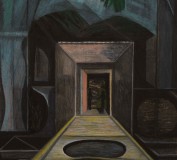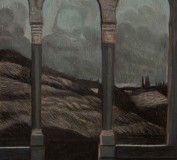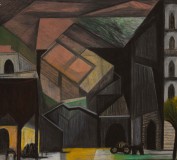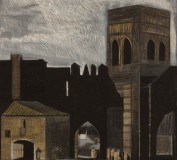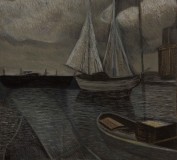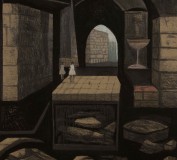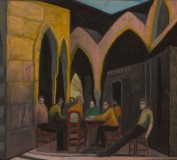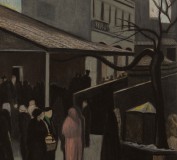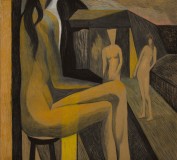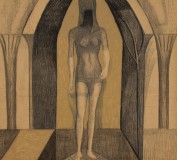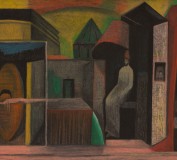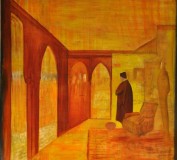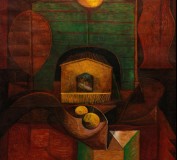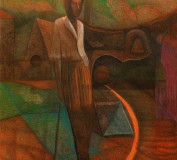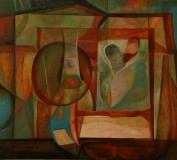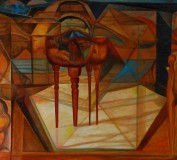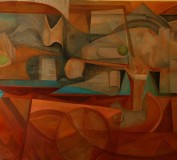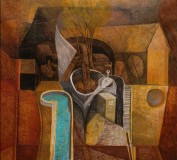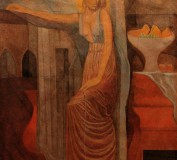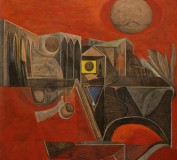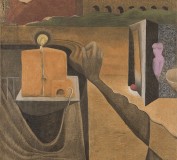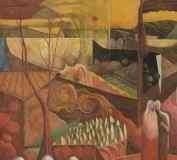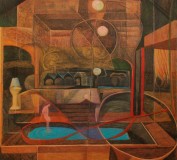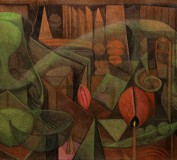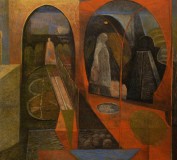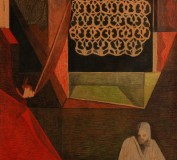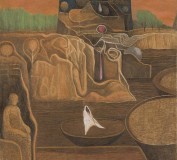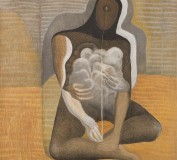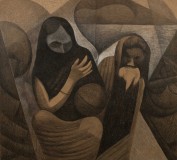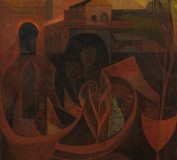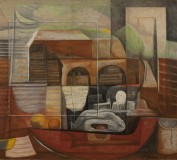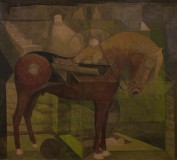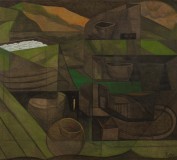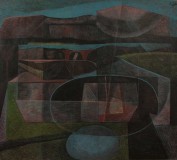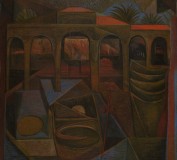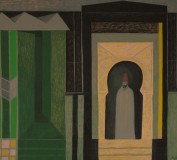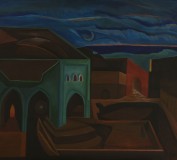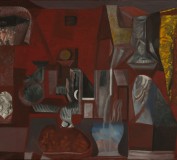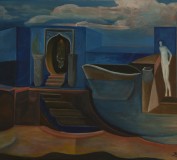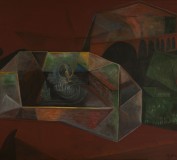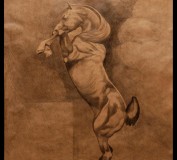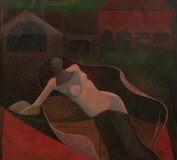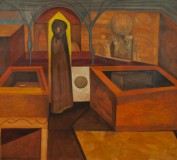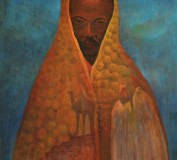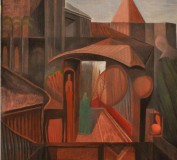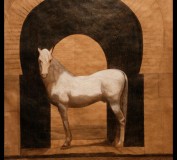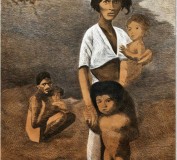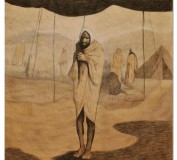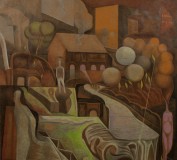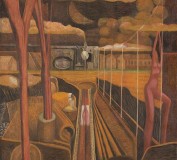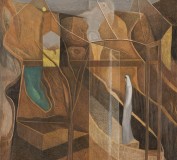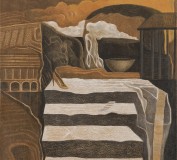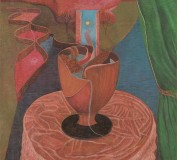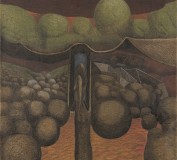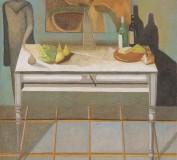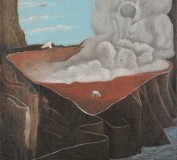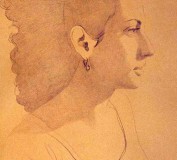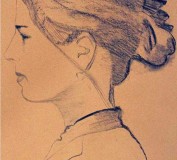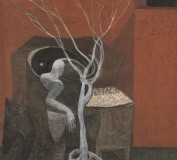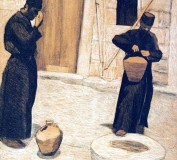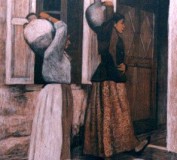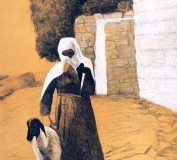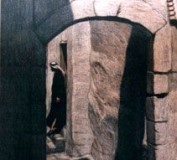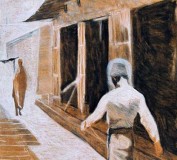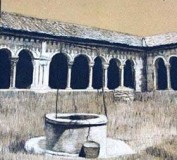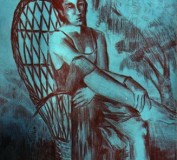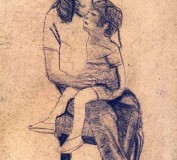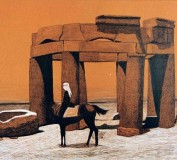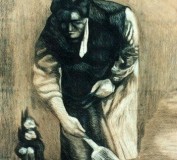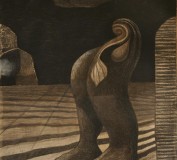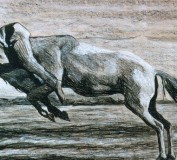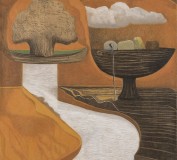PRESS
Reconocido pintor uruguayo Bruno Sfeir expone en Beijing
Por ABEL ROSALES GINARTE
“Para mí fue una sorpresa y una alegría que me invitaran a China”, dijo Bruno Sfeir a China Hoy. Luego de inaugurar la exposición “Dinámica intuitiva” el pasado 28 de mayo como parte de las actividades por el 30.° aniversario de los vínculos diplomáticos entre China y Uruguay en el Recinto Residencial Diplomático de Liangmaqiao, habló de sus expectativas y de los gratos momentos que vivió en la capital china.
“Antes había estado en el país pero en Beijing es la primera vez”. Recordó que hace un tiempo mientras trabajaba en una galería de arte en Florencia, Italia, conoció a una chica china que le dijo: “Tendrías que ir a China con tus obras”. Finalmente la Embajada de Uruguay en China y el Centro de Diplomacia Pública le abrieron las puertas del dragón asiático. Bruno, nació en la ciudad de San José de Mayo en 1970 y estudió en la Escuela Nacional de Bellas Artes de Montevideo. Luego de asistir a talleres de varios maestros, en el año 2007 continuó estudiando en el Instituto Superior de Pintura Van Der Kelen en Bruselas, Bélgica.
Nuevas expectativas
“Tengo la esperanza de que esta exposición que hemos hecho en Beijing sea el inicio de una relación más profunda con este gran país”, destacó Sfeir. Se siente agradecido de que la inauguración de su muestra haya coincidido con la conferencia del ex canciller Enrique Iglesias. “No puedo imaginar mejores circunstancias y mejor carta de presentación considerando lo que el ex canciller Iglesias representa para nuestro país y el mundo”. Agradeció especialmente a las autoridades de Uruguay en China como el embajador Fernando Lugris y a la encargada de asuntos culturales Agustina Casavalle.
“Me llama mucha atención Beijing porque es una ciudad muy vibrante, muy dinámica y moderna. Este país integra conceptos que aparentemente pueden parecer contradictorios pero ellos los integran perfectamente. Entonces uno se encuentra aquí con la tradición y la modernidad conviviendo”. A pesar de su corta estancia la capital de China lo ha conquistado. “Me ha encantado la ciudad. Mi expectativa es que haya interés en mi trabajo y pueda volver para empezar un intercambio más profundo”. Las expectativas crecen porque estamos hablando de un mercado inmenso. “Tendremos que descubrir dónde pueden encajar mis obras pictóricas.
Sus obras de naturaleza introspectiva han conectado con el público chino. “Existen elementos dentro de mis pinturas que también están presentes en la manera de ser de China, en conceptos como la armonía”. Lleva 20 años viviendo fuera de su país en Oriente Medio, Brasil, México, Estados Unidos y actualmente en España. “Mi trabajo de alguna manera se trata del itinerario de un hombre que está en busca de su ser interno y dentro de eso se establece una necesidad de orden, de equilibrio, de armonía y todos esos elementos tienen que ver con China”.
En un ambiente íntimo el público chino disfruta de las obras del artista uruguayo Bruno Sfeir.
Vínculos culturales entre China y Uruguay
Bruno llegó a China tras haber recibido importantes premios en su país como el del Banco de la República Oriental del Uruguay y el del Ministerio de Turismo del Uruguay. Sus obras han recorrido el mundo con exposiciones en diversas naciones del planeta y se encuentran en colecciones públicas y privadas en Uruguay, Argentina, Brasil, Paraguay, Panamá, Chile, México, Líbano, Kuwait (Museo de Arte Moderno), Estados Unidos, Bélgica, España, Francia y China.
“Sé que la Embajada de Uruguay y el Gobierno uruguayo, después de la visita del presidente Tabaré Vázquez en 2016, han aumentado el nivel de relaciones con China. Por ejemplo en Montevideo se creó el Instituto Confucio, un centro cultural chino y hay intercambios de becas”. Dijo sentirse confiado de que los intercambios entre ambas naciones se multiplicarán en el futuro. “Haber llegado en este momento es algo que corre a mi favor porque con los buenos artistas que tiene Uruguay que me hayan elegido es todo un honor. Creo que las relaciones entre los dos países se irán intensificando mucho más”.
Durante el recorrido por su exposición en Beijing muchos de sus cuadros llamaron la atención de los asistentes, especialmente el primero. “El cuadro de la máscara del principio de la exposición representa lo externo, la imagen que mostramos al mundo, a partir de ahí esa máscara se cae y entramos en todo ese mundo interior de símbolos y una relación con el mundo subconsciente en el que está de pronto la verdadera naturaleza del ser que ha pintado eso”.
Sus muchos viajes por el mundo han influenciado sus creaciones artísticas. “No diría que hay algo preestablecido cuando empiezo a hacer un cuadro, existe una reflexión continua como ser humano, una serie de preguntas que pueden ser existenciales que están todo el tiempo presentes y van tomando forma a medida que voy trabajando”. Bruno, tiene la capacidad de fluir como un río en sus obras pictóricas, como muchos de los grandes pintores clásicos de la antigua China. “Son imágenes mentales que van surgiendo y el proceso creativo a veces se vuelve muy agotador”.
El Recinto Residencial Diplomático de Liangmaqiao, en Beijing, acoge las obras del reconocido pintor uruguayo Bruno Sfeir. Fotos de Abel Rosales Ginarte
Una relación más larga
El universo pictórico de Bruno Sfeir convence al público de unirse a ese viaje de símbolos en el que convergen presente, pasado y futuro. “Me he guiado a veces en la vida por la intuición porque la vida siempre propone cosas y es importante no resistirse. Creo que en el fondo de mi ser siempre he querido conocer mundos nuevos, conocer gente distinta, ese deseo me mueve y me presenta estos escenarios”.
Un artista que permite apreciar los muchos caminos que se abren ante nuestros ojos, los caminos visibles y los invisibles también. “Ahora me toca digerir todo esto que he visto en Beijing que luego emergerá en mis futuras obras”. Son obras que acarician el alma, iluminan los sentidos y advierten la magia de la libertad individual. “Espero que pase mucho tiempo y que pueda volver, que hayan recibido de buen grado mi obra, que me consideren un amigo y ojalá que sea el comienzo de una relación más larga”.
El público chino, hijos de una tierra de grandes artistas, con una enorme tradición pictórica, indudablemente han sabido y sabrán apreciar los designios y la personalidad de los cuadros de Bruno Sfeir.
Universe in the State of Alpha – Jacob Klintowitz
Universe in the State of Alpha
JACOB KLINTOWITZ
For a moment we find ourselves struggling to separate that which forms woman and that which shapes the landscape’s spheres. Worlds upon worlds make this a mythical scene devoid of conventionality.
Here and there, once the scene is absorbed, the breasts and face reveal a woman. But what kind of woman is this, shaped from the stars?
This painting, by Bruno Sfeir, is characterised by its high precision. The images are highlighted with clarity by his determined design; delicate chromatics unite the subjects within a bustling rectangle in which we can see a work of extraordinary certainty.
This scientific approach to his work is precisely what accentuates the originality of the images created , his uniqueness and the perpetual sense of the unknown.
A glimpse of a peculiar iconography that doesn’t fail to surprise as it is revealed time and again.
It is possible that this woman is made from more than just the star-dust of dreams.
The paintings of Sfeir alter the limits of conventional understanding and in them we live in the chimera, in the innovative poetics that interweave logic with new connections.
Landscapes, objects and beings make unexpected combinations. For Bruno Sfeir, these are intriguing and show something new of himself.
Landscapes, mythical scenes, imaginary scenes, immemorial fragments of abrupt lights. Perhaps a self-portrait of the artist himself when he was still young…
Instigators for the artist himself?
In this case, that he is the first eyewitness.
There is a distinct distance between the artist in the creative act and the contemplative artist.
The observation of the work requires wit and detachment from it, an ability to remove parts of the artist’s own language.
The beholder is similar but at the same time different from the painter. When creating, the artist awakens, becomes more integrated and receptive.
From the obvious biographical experience of our time comes the easy conclusion that the artist is superior to man.
Bruno Sfeir is moved by discoveries. This is what motivates him. His art brings awareness, promotes the existence, organizes correctly and makes visible what was before only sensed.
In this case, intuition is so present, that it presides over the movement, directs the painter in his ongoing effort, bringing forth that which is hidden within himself.
It is the reason for Sfeir’s intense pictorial production, this succession of images and particular scenes.
And intuition dominates the invention of his paintings in such a way as to be thier own fuel.
The reality of art is inferior when compared with intuition and is an effort to make these two acts in the world, the concrete appearance and the prescient insight of the form, identical to the fundamental stimulus of Bruno Sfeir and of all true artists.
Sfeir makes it visible but not intelligible.
It is, without question, an account of the dawn of the spirit.
Do not imagine that the process of this artist is simple image association, far from it. It is a process of cultivated elaboration and introspection.
Before us is not an automatic script or a significant image association, but rather a method of creation in which the artist removes the obstacles obscuring its perception and connects with the immediacy of the images, while maintaining control over their activity.
The discourse is that difficult cohabitation between availability and garnered knowledge: one of the virtues of the artist.
It is evident that Bruno Sfeir’s painting is infused with surrealism. But, while a strong manifestation of the subconscious pulls his work towards this movement, there is another that escapes it, as his approach is personal and distinct.
In general it is but a meeting of irrational vertices. In particular, a unique iconography, the construction of a group of personal images.
Finally, after the establishment of profound psychology as daily fact, standardization of concepts of the individual subconscious, collective subconscious, archetypes of the comparative history of religions, of mythology as a way of consciousness; practically all art forms use, in their creation, matter originating in the subconscious and in civilizations past.
Victoriously, Surrealism dissolves in the body of culture.
Bruno Sfeir’s true artistic family is that of the official travelling artists.
Respectable are those who, before the innovation of instant photography, accompanied scientific expeditions recording flora, fauna and social life.
This art developed into records to leave a formidable collection for humanity. Some prominent examples are; Thomas Ender, Johan Moritz Rugendas, Albert Eckhout and Henry Chamberlain, among many.
But, I have always considered the independent recording Oceania, by Paul Gauguin, to be the most emotional. And above all, the recordings by Leonardo da Vinci of the research his own curiosity would establish.
It is from this source that a new family of artists emerge, travellers who determine their own area of investigation.
What of art will now be the new emerging focus of our times if not the living perception of capturing and recording a lasting image, and the expansion of the limits which surround our concept of reality.
The journey is within oneself. Art is a journal of the most formidable entries, the discovery of oneself.
Adjoin high and low, heaven and earth; God and man.
The artist is his own subject of investigation. To paint is, in this particular instance, to limit the universe within a determined space. The world is a rectangle.
There is a place beyond our comprehension, where lies our true knowledge and from which one can contemplate the universe as a whole.
This is somehow the true function of art. Along with and beyond the chronicles that are our daily lives.
The universe in the state of Alpha.
Bruno Sfeir feels he has a melody, a melody that at times discloses a chord or two. This is his music and one which he will always be in search of.
This highly personal repertoire can be found in all of us, at least in part. It is what permits recognition.
And if that music were entirely unknown, it would be so forever.
LERC and NDU attend The National Feast Day of Uruguay
LERC and NDU attend The National Feast Day of Uruguay
Thursday, 19th June, 2008. LERC, NDU.
At the invitation of H.E. Jorge Luis Jure Arnoletti, Ambassador of Uruguay, Ms Guita Hourani, Director of the Lebanese Emigration and Research Center, attended the National Feast Day of Uruguay that took place at the Hall of the Municipal Palace in Jounieh on June 19th 2008.
The event was an opportunity for LERC to meet the Lebanese-Uruguayan community and while Ms. Hourani represented the NDU President and the Vice President of Research and Development, LERC was also represented by Mr. Roberto Khatlab, LERC’s Liaison Officer for Latin America.
The event was held in collaboration with the President of the Town Hall of Jounieh, Mr. Juan Hobeich, and was attended by many prominent personalities including the Minister of Foreign Affairs Mr. Faouzi Salloukh representing the President of Lebanon Michel Sleiman; Deputy Mr. Naamtallah Abi Nasser representing the President of the National Assembly Mr. Nabih Berri, and Mr. Nassif Kallouch, Governor of Beirut and the North representing the Lebanese Prime Minister Fouad Siniora.
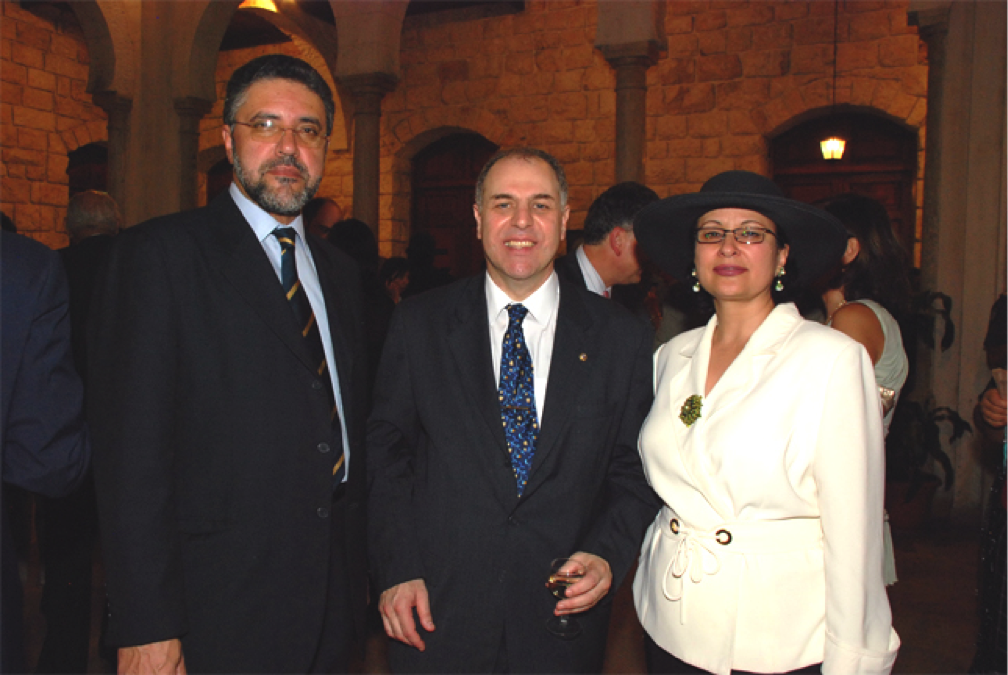
Uruguay’s celebrates its National Day Feast (L-R) Roberto Khatlab, LERC’s Latin America Liaison Officer, H.E the Ambassador of Uruguay, Jorge Luis Jure Arnoletti, and Guita Hourani, Director of LERC
The event itself was to mark the 244th birthday of Jose Artigas, a national hero in Uruguay, who had stood up for sovereignty and unity of the South American people while at the same time balancing the desire for independence with the need to maintain friendly ties throughout the region.
Several of its close South American neighbors including Mexico, Paraguay, Columbia, and Cuba were represented by their Ambassadors.
Also present at the occasion were MGR Roland Abou Jaoude representing His Beatitude
Nasrallah Boutros Sfeir, Attorney Antoine Richa and Attorney Walid Fares representing
President Amine Gemayel; Mr. Michel Chadarevian representing the former prime minister and Deputy Michel Aoun, Dr. Daoud El Sayegh representing Deputy Saad Hariri, the President of the Municipal Council of Ghazir, Mr. Ibrahim Haddad, the Colonel Fabio Matiasse representing Mr. Claudio Grazziano and Deputy Hassan Yaacoub Member of the Parliamentary Group of Friends of Uruguay.
In his welcome address, H.E. the Ambassador of Uruguay, Jure Arnoletti emphasized the special and historic relationship existing between Lebanon and Uruguay. This began with consular relations in the 1920’s and full diplomatic relations in 1945 after Lebanon’s independence.
He explained that since the early nineteenth century Lebanese immigrants coming into Uruguay had began the process of their integration into all levels of Uruguay’s social and cultural life.
In this light the Ambassador introduced the exhibition of the Uruguayan painter Mr. Bruno Sfeir, born in 1970 of mixed Lebanese and Italian descent, his grandfather having emigrated from Reyfoun to Uruguay in the early 20th Century. His paintings exhibited at the event reflected a true vision of Uruguayan society, according to H.E Jure Arnoletti.
Since 1987 Mr. Sfeir’s work has been recognized and awarded several prizes and the painter has held many exhibitions of his work bringing his images of Uruguayan life to people throughout the world. According to his biography, Sfeir’s paintings can be found in public institution and private collections in Uruguay, Argentina, Brazil, Panama, Chile, Mexico, Lebanon, Kuwait ( Museum of Modern Art), USA, Belgium, Spain, France and China.
Mr. Sfeir’s work is best described in the words of Jacob Klintowitz, who defined them as “characterized by high precision. The determined design highlights the figures with clarity; the chromatics a delicate scheme which unites the subjects and the scenes with an entirely active rectangle, in which one can observe, besides the appearance, a composition of rare certainty. That scientific approach to his work is exactly what accentuates the originality of the images created by the artist, his particularity and the everlasting sensation of incognito. A glimpse of a peculiar iconography that reveals itself and surprises every time.”
The Ambassador then concluded by thanking the staff at the Embassy for their support during his first year in the country, the Honorary Consul of Uruguay Mr. Chaghoury and the Honorary Attache Miss Chelela, while extending his gratitude to Lebanese friends for attending, and greeting the Lebanese in general for their infectious enthusiasm and love of life.
Bruno Sfeir: Paisajes y pinturas que estuvieron escondidos en el alma
| Bruno Sfeir: Paisajes y pinturas que estuvieron escondidos en el alma |
|
Sandra Acosta |

El próximo viernes a las 20 horas en el Museo de San José se inaugurará una exposición de trabajos artísticos de Bruno Sfeir, joven artista maragato de indiscutible proyección internacional cuya última exposición se realizó nada menos que en el Salón de los Pasos Perdidos de la sede de UNESCO en París. PH: Empezaste a pintar siendo muy joven. ¿Cuándo descubriste que deseabas expresarte y vivir a través del arte? Expresarme a través del arte fue un proceso natural y espontáneo que comenzó a mis nueve anos y no tuvo interrupciones hasta el día de hoy. PH: En tu obra se aprecia una influencia constructivista, pero es al mismo tiempo surrealista y siempre cargada de símbolos. ¿Cómo definirías tu estilo (si eso es posible)? ¿Qué vertientes lo han determinado? ¿Maestros, viajes, vivencias, intuición? Creo que mi trabajo esta determinado por todo lo que mencionas en tu pregunta. La formación que recibí en algunos talleres fue valiosa, y los viajes y experiencias de vida han nutrido la obra. No me cuestiono demasiado cual es mi estilo. Me interesa vivir la experiencia, esto es, el acto de pintar. En cada pintura que comienzo siento que emprendo un viaje. Me mantengo receptivo, expectante, sin ansiedad y el ser va tomando nota de lo que percibe en el recorrido. De este modo, la obra va tomando forma. Es un proceso que aunque lento, lo vivo con gran intensidad. Al final, cuando contemplo el trabajo realizado, tengo la sensación de que las pinturas estaban hechas en mi interior y solo requerían de atención y esfuerzo para salir a la superficie. No encuentro nombre para definir esa experiencia. PH: Trabajas en distintas técnicas (óleo, grafito, tinta…). ¿Cuál es la que consideras más “propia”? No tengo predilección por una técnica en particular… PH: ¿En qué consiste la muestra que inauguras el viernes en el Museo de San José? La muestra consta de diecinueve obras; diez oleos s/ tela y nueve dibujos (óleo pasteles ). Son trabajos que evocan experiencias y viajes tratados desde mi imaginación. Las medidas van desde 100 X 80 cm hasta 140 X 120 cm. Los fuegos de artificio en el arte PH: Muchos consideramos que hay- en general- en el arte nacional actual, poca sustancia y mucho efectismo. ¿Cuál es tu opinión sobre la situación del arte uruguayo? Aunque debe haber aportes valiosos, en general coincido con tu apreciación. Tal vez este hecho tenga un trasfondo profundo (no solo en el Uruguay) que el arte esta reflejando de muchas maneras. Creo que este vacío de contenidos y efectismos esta vinculado -entre otras razones- a una ansiedad por lo novedoso, y esta ansiedad a su vez esta relacionada a un ritmo de vida que demanda celeridad y ser efectivo. Pero el proceso de crecimiento y desarrollo de una obra consistente tiene su propio ritmo y uno debe decidir si se deja avasallar por el mundo de la prisa o no. También hay que tener en cuenta que hay intereses creados y esto lleva a promover algunas formas de arte y dejar caer otras. Pasado un buen tiempo- como siempre ha sucedido- habrá que discriminar y los trabajos que eran solo efectos, como fuego de artificio desaparecerán. |
The Daily Star
 |
|
|
Bruno Sfeir’s surrealism: beyond the fronteras of nation states Juººly 30, 2008 12:00 AM By Laura Wilkinson Bruno Sfeir’s surrealism: beyond the fronteras of nation states July 30, 2008 12:00 AM By Laura Wilkinson
JOUNIEH: “My contact with Lebanon,” Bruno Sfeir admits, “is a very new one.” The Uruguayan painter, whose works have been on display at Jounieh’s municipal palace for the last month or so, explains his Lebanese-Italian origins have sometimes pressured him to feel “Lebanese.” “In Uruguay,” he says, “I once met a Lebanese man, 100 percent Lebanese, who on discovering my origins, told me I was Lebanese. ‘But I am Uruguayan,’ I said, ‘born and raised here.’ “‘No!’ he retorted firmly, ‘You are a nacido,’ a Lebanese born in Uruguay.” Relating this anecdote with a smile, Sfeir points out that he doesn’t speak Arabic and, if he had to put himself into a box, would describe himself as a Latin American plastic artist. There are many symbols in Sfeir’s work – spindly keys, winding stairwells, distorted thresholds, and sweeping landscapes – that could easily be read as evocations of a search for a home or homeland, perhaps a sense of belonging. The poem that Sfeir devised to accompany the exhibition – his 17th since 1987 – suggests the symbols in his works, indeed the structure of the works themselves, relay something much more abstract than identity or belonging. “Are you looking for knowledge or for safety?” the poem reads. “… Leave your personal history and judgments aside.” Sfeir states that, in fact, he is not interested in nationality. “I’m not interested in these categories, ‘American,’ ‘Lebanese,’ ‘Uruguayan,'” he says. “I want to break these fronteras, these boundaries, and paint as a human being.” He suggests his works are more concerned with existential matters, a “journey” that may be influenced by external objects but one that is ultimately internal. Sfeir painted the works in his current exhibition in 2006 and 2007, mostly in Brasilia but some in Lebanon too. He says his work has had different stages and that this collection is very different from his past works – which came after a deep experience, after living in Kuwait. “Living in the desert is intense,” he says. “We have beautiful things [in Lebanon] – growth, nature, trees, birds, things that give good sensations. But living in Kuwait made me retreat into myself, go within myself, and so I found things within me.” There is a strong suggestion of both the immaterial and material in this work – as in “The Observers,” with its repeated motifs of moons, eggs, trees awaiting spring. There are also themes of movement – as in the boats, stairs and ambiguous portals of “Subtle Door.” Sfeir’s works are reminiscent of the school of art initiated by Uruguayan artist Joaquin Torres Garcia (1874-1949), whose symbolism employs such small objects – bowls, eggs and the like – as well as ladders, as organic wooden tones. It comes as little surprise that Sfeir studied Torres Garcia as part of his masters degree in fine arts. Along with the Cubist and Constructivist elements apparent in his works, there also seems to be an exploration of stasis and movement. Torres Garcia was concerned with re-examining Latin American art, with an emphasis on the pre-Colombian tradition, “an authentic culture” as Sfeir puts it. “Torres Garcia influenced me to look at other cultures, but it’s not so much about ‘pre-Colombian’ but about authenticity, and tradition. “His disciples, such as [Uruguayan artist] Gonzalo Fonseca [1922-1997] often studied in Arab countries, looking for ‘authentic’ culture, for purer traditions. In the Occident, things are mixed up.” The artist says that his main influence has been the Surrealist movement. The oil pastel-on-canvas paintings on offer at Jounieh’s municipal palace do have some fleeting references to the Middle East – a veiled woman for example. But the inclusion of this was, as Sfeir says, not a conscious decision but more a suggestion of mystery to tie in with the burden of searching within the unknown. Not all Sfeir’s works are abstract. Some simple and delicate sanguine-on-paper drawings touch upon the “authentic” and the uncomplicated. A group of tarboush-wearing boys huddle under a tree, brought together by curiosity about an object – held just beyond the spectator’s view. Their puzzlement, and the pecking order of who gets to have a look, are captured beautifully as they circle around the boy holding the coveted something. “You can be connected to an external object,” says Sfeir, “but you need to draw something out from within you. The connection is with your inner self.” He describes the process of painting as, for him, spontaneous. He makes no sketches and works directly on the canvas, which gives him the feeling of being “in two places at once.” Sfeir’s skill with oil pastel is perhaps what makes this exhibition so impressive. Composing such geometrically complex works with minute feathered strokes – with gradual warm blushes of color contrasting with his more somber, shadowed pieces – establish a rigid composition built up with soft tones. Among the more abstract suggestions of “burdens” and existential crises, Sfeir’s exhibition includes some spectacular landscapes, with interesting and obscure additions – cubic angles and invisible doorways. All invite new perspectives. Bruno Sfeir’s exhibition at the Jounieh Municipal Palace closes on July 31. Call +961 9 913 000 for more information. For those who missed this show, his work can be seen at http://www.brunosfeir.com Read more: http://www.dailystar.com.lb/Culture/Arts/Jul/30/Bruno-Sfeirs-surrealism-beyond-the-fronteras-of-nation-states.ashx#ixzz1QXddqwzJ |
Bruno Sfeir at UNESCO in Paris; an exceptional artist.
Within the framework of the International Year for the Rapprochement of Cultures proclaimed by UNESCO for 2010, delegations from Lebanon and Uruguay at UNESCO have organized an exceptional exhibition, topic “Subjectivity and Certainty” by the international Lebanese-Uruguayan artist Bruno Sfeir.
In the presence of many official personalities like the UNESCO General Conference’s President Mr. Davidson Hepburn, the Lebanese Ambassador for UNESCO Mrs Sylvie Fadlallah, the Uruguayan delegate for business Mr. Santiago Wins, Bruno Sfeir exhibited 12 nameless canvas for the viewers to do a personal and free artistic journey.
Bruno Sfeir has an incredible capacity to reconcile reason, emotion and intuition. Even being very rigorous he preserves and pursuits the source and the purpose of his inner pursuit.
Concerning the external, his painting is abstract and almost geometrical but it introduces the viewer into his inner universe.
His work of art is a true invitation to travel, an inexorable entrance through a prism, a labyrinth of symbols and clues that brings things together in perfect harmony. The artist guides us through a path where we cannot get lost and at the same time he leads us into the
depth of his different level perspectives. He leaves at the viewer’s disposal the openings and closures proposed through the symbols of love, death, resurrection, take root and spirituality.
His metamorphosis and metaphors are neither distressing nor arbitrary as they show the complexity of life and they do not imply a rupture or a breakdown but a serene disposition.
It is almost natural to go from one space to another without getting lost.
In his painting we can find a playful aspect that gives liveliness and a constructed aspect that provides reassurance. At the same time as it gives a good account of the geometrical intersection of rationality (space / time) it is combined with reliefs which illuminate and guide.
Finally, the adjustments of shapes and colours work by themselves as his universe has essential values of elevation, freedom and transcendence.
Bruno’s painting reminds us in some aspects about those of the great master Rene Magritte but it follows totally different purposes. We can often find in both paintings the same symbols: the bird, the key, the cup… Whereas these objects appear in Magritte’s painting (in his own words) in a willful and risky way in Sfeir’s painting they acquire (on purpose) other gravity or seriousness. His painting is surrealist and spiritual at the same time. This is the reason of his singularity and originality.
Bruno Sfeir joins modernity with the imperative of the sense; it is a powerful example of dialogue between cultures with an abstract occidental technique and an inner baroque Latin American pursuit or oriental mysticism. In his own words, his painting is the one of the “investigator”, “friend”, “pilgrim”, that of the “presence”, “wisdom”, “peace” and “light”.
Sfeir’s painting is very well achieved and it conveys inner worlds that come up as a large number of clues, alternatives, choices. His painting is not immediate, demanding or dogmatic because while it is
disciplined it suggests several levels of significance, several understanding of the work that the viewer has to explore herself / himself. His great originality consists in bringing together or joining discovery and familiarity.
Bruno Sfeir is proud of his Lebanese roots as well as his Uruguayan belonging and his international opening. His work illustrates in a brilliant way the approach of cultures. His exhibition at UNESCO in Paris has been a real triumph which deserves to be shared among everyone who associates the cedars’ homeland with creativity, innovation, intellectual and conceptual rigor and spirituality.
Bahat Rizk.
